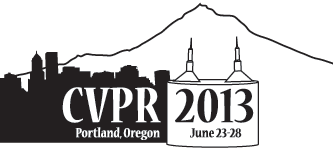-
A Higher-Order CRF Model for Road Network Extraction
AbstractThe aim of this work is to extract the road network from aerial images. What makes the problem challenging is the complex structure of the prior: roads form a connected network of smooth, thin segments which meet at junctions and crossings. This type of a-priori knowledge is more difficult to turn into a tractable model than standard smoothness or co-occurrence assumptions. We develop a novel CRF formulation for road labeling, in which the prior is represented by higher-order cliques that connect sets of superpixels along straight line segments. These long-range cliques have asymmetric P es-potentials, which express a preference to assign all rather than just some of their constituent superpixels to the road class. Thus, the road likelihood is amplified for thin chains of superpixels, while the CRF is still amenable to optimization with graph cuts. Since the number of such cliques of arbitrary length is huge, we furthermore propose a sampling scheme which concentrates on those cliques which are most relevant for the optimization. In experiments on two different databases the model significantly improves both the per-pixel accuracy and the topological correctness of the extracted roads, and outperforms both a simple smoothness prior and heuristic rulebased road completion.
Related Material
[pdf][bibtex]@InProceedings{Wegner_2013_CVPR,
author = {Wegner, Jan D. and Montoya-Zegarra, Javier A. and Schindler, Konrad},
title = {A Higher-Order CRF Model for Road Network Extraction},
booktitle = {Proceedings of the IEEE Conference on Computer Vision and Pattern Recognition (CVPR)},
month = {June},
year = {2013}
}
CVPR 2013 open access
These CVPR 2013 papers are the Open Access versions, provided by the Computer Vision Foundation.
Except for the watermark, they are identical to the accepted versions; the final published version of the proceedings is available on IEEE Xplore.
Except for the watermark, they are identical to the accepted versions; the final published version of the proceedings is available on IEEE Xplore.
This material is presented to ensure timely dissemination of scholarly and technical work.
Copyright and all rights therein are retained by authors or by other copyright holders.
All persons copying this information are expected to adhere to the terms and constraints invoked by each author's copyright.

